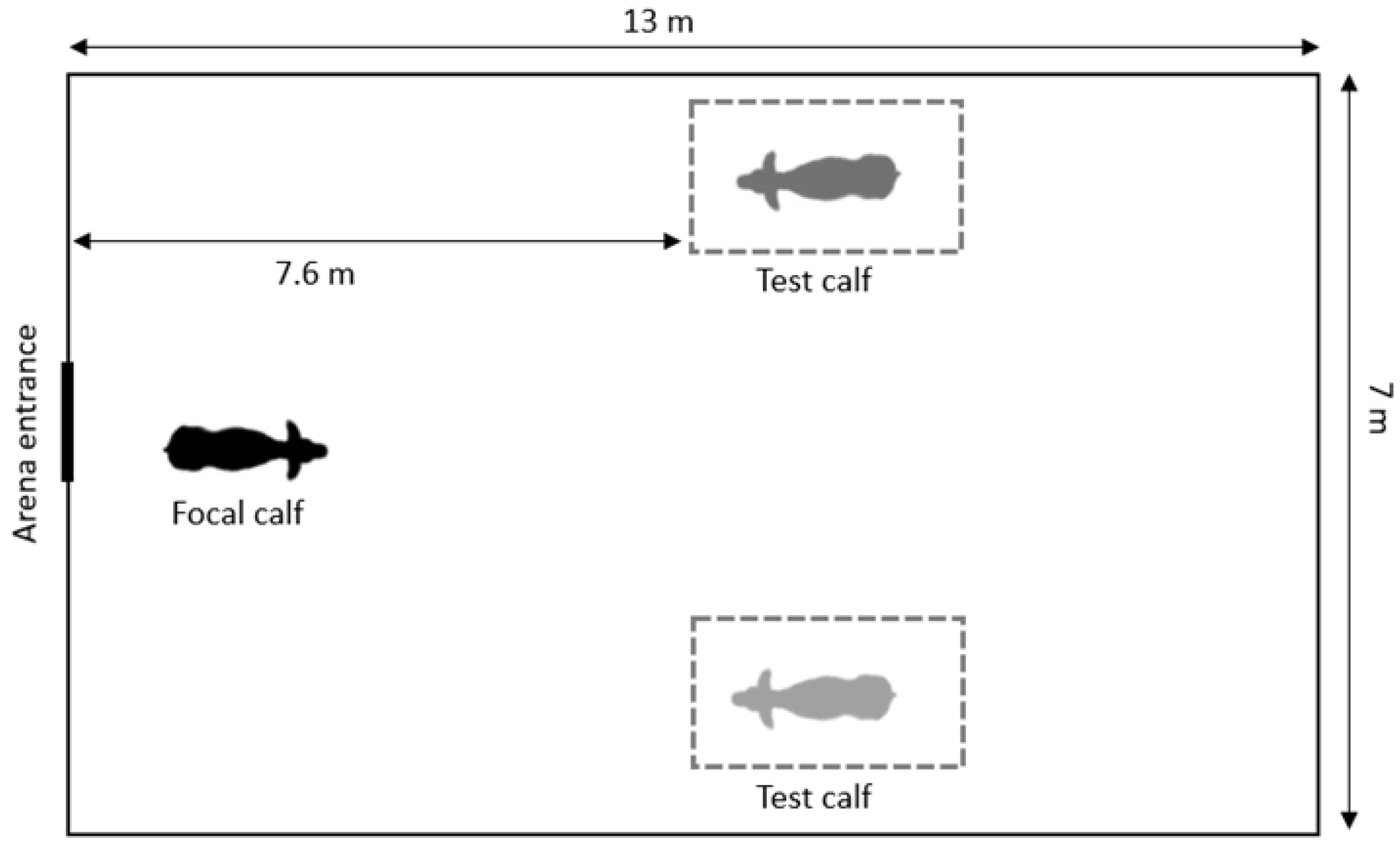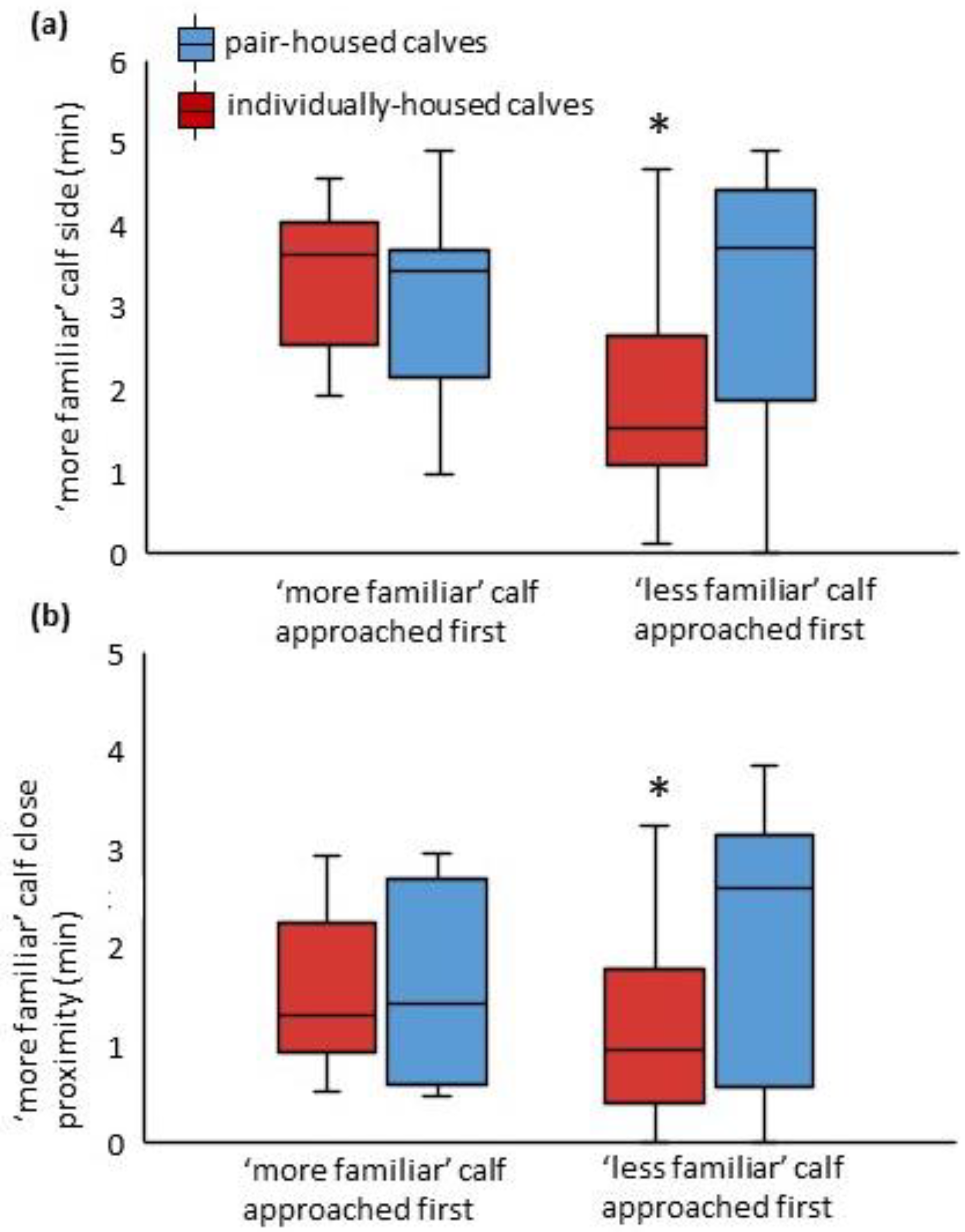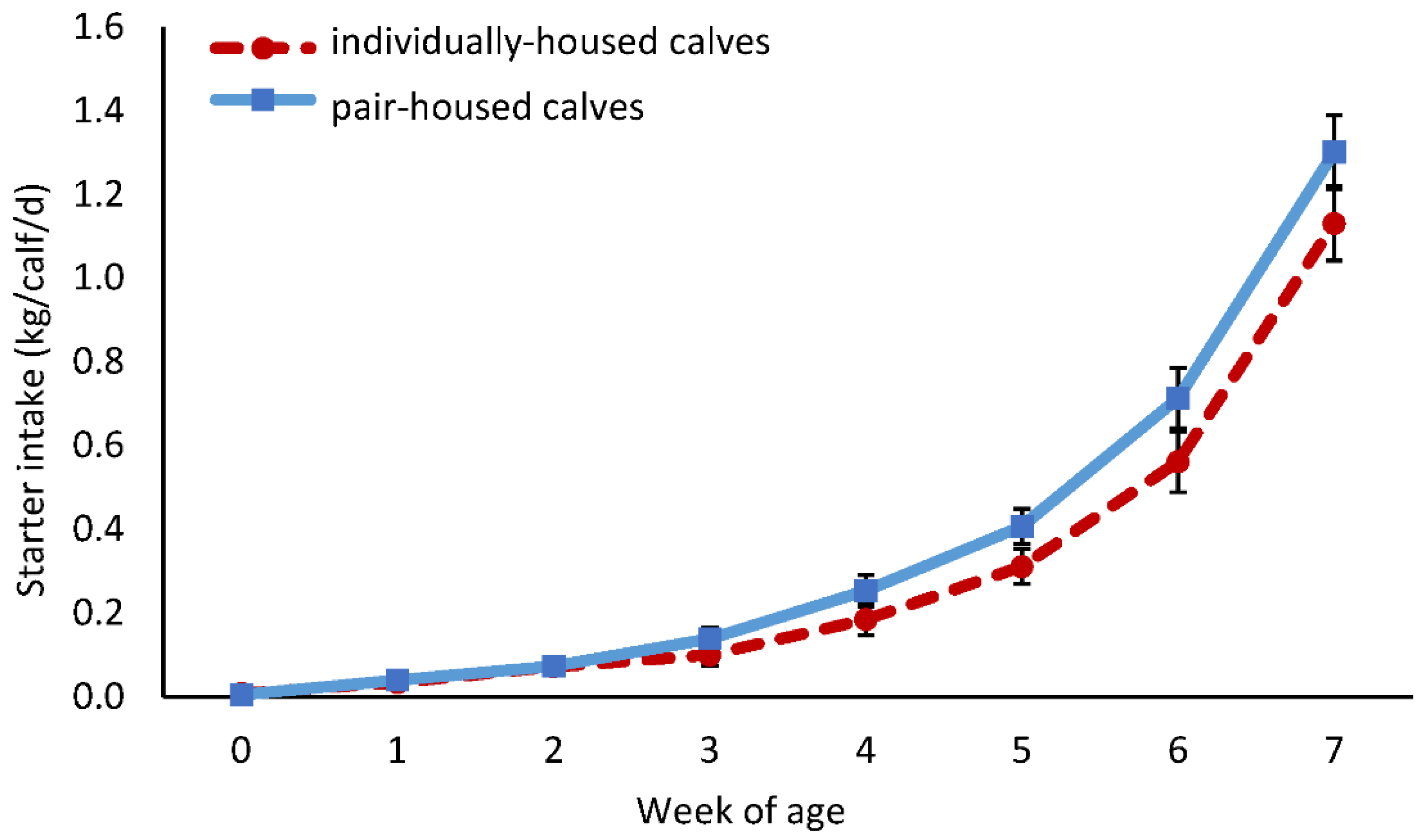Effects of Social Housing on Dairy Calf Social Bonding
Abstract
:Simple Summary
Abstract
1. Introduction
2. Materials and Methods
2.1. Animals, Management, and Experiment Design
2.2. Performance Data Collection
2.3. Behavioral Testing
2.4. Calculations and Statistical Analysis
3. Results
3.1. Effects of Housing Treatment on Total Duration of Calf-Directed Behavior
3.2. Effects of the First Calf Approached and Housing Treatment on Duration of Behavior Directed toward the ‘More Familiar’ Calf
3.3. Effects of Housing Treatment on Social Preference Ratios When Both Stimulus Calves Were Approached
3.4. Effects of Social Housing on Calf Performance
4. Discussion
5. Conclusions
Supplementary Materials
Author Contributions
Funding
Institutional Review Board Statement
Informed Consent Statement
Data Availability Statement
Acknowledgments
Conflicts of Interest
References
- Newberry, R.C.; Swanson, J.C. Implications of Breaking Mother-Young Social Bonds. Appl. Anim. Behav. Sci. 2008, 110, 3–23. [Google Scholar] [CrossRef]
- Rørvang, M.V.; Nielsen, B.L.; Herskin, M.S.; Jensen, M.B. Prepartum Maternal Behavior of Domesticated Cattle: A Comparison with Managed, Feral, and Wild Ungulates. Front. Vet. Sci. 2018, 5, 45. [Google Scholar] [CrossRef] [PubMed] [Green Version]
- Clutton-Brock, J. A Natural History of Domesticated Mammals; Cambridge University Press: Cambridge, UK, 1999. [Google Scholar]
- United States Department of Agriculture. Dairy 2014, Part 1: Dairy Cattle Management Practices in the United States; USDA: Fort Collins, CO, USA, 2016.
- Bolt, S.L.; Boyland, N.K.; Mlynski, D.T.; James, R.; Croft, D.P. Pair Housing of Dairy Calves and Age at Pairing: Effects on Weaning Stress, Health, Production and Social Networks. PLoS ONE 2017, 12, e0166926. [Google Scholar] [CrossRef] [PubMed]
- Lv, J.; Zhao, X.W.; Su, H.; Wang, Z.P.; Wang, C.; Li, J.H.; Li, X.; Zhang, R.X.; Bao, J. Effects of Group Size on the Behaviour, Heart Rate, Immunity, and Growth of Holstein Dairy Calves. Appl. Anim. Behav. Sci. 2021, 241, 105378. [Google Scholar] [CrossRef]
- Duve, L.R.; Jensen, M.B. Social Behavior of Young Dairy Calves Housed with Limited or Full Social Contact with a Peer. J. Dairy Sci. 2012, 95, 5936–5945. [Google Scholar] [CrossRef] [PubMed]
- Hepola, H.; Hänninen, L.; Pursiainen, P.; Tuure, V.M.; Syrjälä-Qvist, L.; Pyykkönen, M.; Saloniemi, H. Feed Intake and Oral Behaviour of Dairy Calves Housed Individually or in Groups in Warm or Cold Buildings. Livest. Sci. 2006, 105, 94–104. [Google Scholar] [CrossRef]
- Babu, L.K.; Pandey, H.N.; Sahoo, A. Effect of Individual versus Group Rearing on Ethological and Physiological Responses of Crossbred Calves. Appl. Anim. Behav. Sci. 2004, 87, 177–191. [Google Scholar] [CrossRef]
- Miller-Cushon, E.K.; DeVries, T.J. Effect of Social Housing on the Development of Feeding Behavior and Social Feeding Preferences of Dairy Calves. J. Dairy Sci. 2016, 99, 1406–1417. [Google Scholar] [CrossRef] [Green Version]
- Bernal-Rigoli, J.C.; Allen, J.D.; Marchello, J.A.; Cuneo, S.P.; Garcia, S.R.; Xie, G.; Hall, L.W.; Burrows, C.D.; Duff, G.C. Effects of Housing and Feeding Systems on Performance of Neonatal Holstein Bull Calves. J. Anim. Sci. 2012, 8, 2818–2825. [Google Scholar] [CrossRef] [Green Version]
- Costa, J.H.C.; Meagher, R.K.; von Keyserlingk, M.A.G.; Weary, D.M. Early Pair Housing Increases Solid Feed Intake and Weight Gains in Dairy Calves. J. Dairy Sci. 2015, 98, 6381–6386. [Google Scholar] [CrossRef]
- Jensen, M.B.; Vestergaard, K.S.; Krohn, C.C.; Munksgaard, L. Effect of Single versus Group Housing and Space Allowance on Responses of Calves during Open-Field Tests. Appl. Anim. Behav. Sci. 1997, 54, 109–121. [Google Scholar] [CrossRef]
- Costa, J.H.C.; Daros, R.R.; von Keyserlingk, M.A.G.; Weary, D.M. Complesx social housing reduces food neophobia in dairy calves. J. Dairy Sci. 2014, 97, 7804–7810. [Google Scholar] [CrossRef] [PubMed]
- Veissier, I.; Boissy, A.; Nowak, R.; Orgeur, P.; Poindron, P. Ontogeny of Social Awareness in Domestic Herbivores. Appl. Anim. Behav. Sci. 1998, 57, 233–245. [Google Scholar] [CrossRef]
- Raussi, S.; Niskanen, S.; Siivonen, J.; Hänninen, L.; Hepola, H.; Jauhiainen, L.; Veissier, I. The Formation of Preferential Relationships at Early Age in Cattle. Behav. Processes 2010, 84, 726–731. [Google Scholar] [CrossRef] [PubMed]
- Reinhardt, V.; Mutiso, F.M.; Reinhardt, A. Social Behaviour and Social Relationships between Female and Male Prepubertal Bovine Calves (Bos Indicus). Appl. Anim. Ethol. 1978, 4, 43–54. [Google Scholar] [CrossRef]
- Færevik, G.; Jensen, M.B.; Bøe, K.E. Dairy Calves Social Preferences and the Significance of a Companion Animal during Separation from the Group. Appl. Anim. Behav. Sci. 2006, 99, 205–221. [Google Scholar] [CrossRef]
- Gutmann, A.K.; Špinka, M.; Winckler, C. Long-Term Familiarity Creates Preferred Social Partners in Dairy Cows. Appl. Anim. Behav. Sci. 2015, 169, 1–8. [Google Scholar] [CrossRef]
- Færevik, G.; Andersen, I.L.; Jensen, M.B.; Bøe, K.E. Increased Group Size Reduces Conflicts and Strengthens the Preference for Familiar Group Mates after Regrouping of Weaned Dairy Calves (Bos Taurus). Appl. Anim. Behav. Sci. 2007, 108, 215–228. [Google Scholar] [CrossRef]
- Val-Laillet, D.; Guesdon, V.; von Keyserlingk, M.A.G.; de Passillé, A.M.; Rushen, J. Allogrooming in Cattle: Relationships between Social Preferences, Feeding Displacements and Social Dominance. Appl. Anim. Behav. Sci. 2009, 116, 141–149. [Google Scholar] [CrossRef]
- Duve, L.R.; Jensen, M.B. The Level of Social Contact Affects Social Behaviour in Pre-Weaned Dairy Calves. Appl. Anim. Behav. Sci. 2011, 135, 34–43. [Google Scholar] [CrossRef]
- Federation of Animal Science Societies. Guide for the Care and Use of Agricultural Animals in Research and Teaching, 4th ed.; FASS: Champaign, IL, USA, 2020. [Google Scholar]
- McGuirk, S.M. Disease Management of Dairy Calves and Heifers. Vet. Clin. N. Am. Food Anim. Pract. 2008, 24, 139–153. [Google Scholar] [CrossRef] [PubMed]
- Kappel, S.; Mendl, M.T.; Barrett, D.C.; Murrell, J.C.; Whay, H.R. Lateralized Behaviour as Indicator of Affective State in Dairy Cows. PLoS ONE 2017, 12, e0184933. [Google Scholar] [CrossRef] [PubMed]
- Adámková, J.; Svoboda, J.; Benediktová, K.; Martini, S.; Nováková, P.; Tůma, D.; Kučerová, M.; Divišová, M.; Begall, S.; Hart, V.; et al. Directional Preference in Dogs: Laterality and “Pull of the North”. PLoS ONE 2017, 12, e0185243. [Google Scholar] [CrossRef] [Green Version]
- McDowell, L.J.; Wells, D.L.; Hepper, P.G. Lateralization of Spontaneous Behaviours in the Domestic Cat, Felis Silvestris. Anim. Behav. 2018, 135, 37–43. [Google Scholar] [CrossRef] [Green Version]
- Friard, O.; Gamba, M. BORIS: A Free, Versatile Open-Source Event-Logging Software for Video/Audio Coding and Live Observations. Methods Ecol. Evol. 2016, 7, 1325–1330. [Google Scholar] [CrossRef]
- Hagen, K.; Broom, D.M. Cattle Discriminate between Individual Familiar Herd Members in a Learning Experiment. Appl. Anim. Behav. Sci. 2003, 82, 13–28. [Google Scholar] [CrossRef]
- Jablonski, N.G. Social and Affective Touch in Primates and Its Role in the Evolution of Social Cohesion. Neuroscience 2021, 464, 117–125. [Google Scholar] [CrossRef]
- Majolo, B.; Schino, G.; Aureli, F. The Relative Prevalence of Direct, Indirect and Generalized Reciprocity in Macaque Grooming Exchanges. Anim. Behav. 2012, 83, 763–771. [Google Scholar] [CrossRef]
- Newton-Fisher, N.E.; Lee, P.C. Grooming Reciprocity in Wild Male Chimpanzees. Anim. Behav. 2011, 81, 439–446. [Google Scholar] [CrossRef]
- Holm, L.; Jensen, M.B.; Jeppesen, L.L. Calves’ Motivation for Access to Two Different Types of Social Contact Measured by Operant Conditioning. Appl. Anim. Behav. Sci. 2002, 79, 175–194. [Google Scholar] [CrossRef]
- Grignard, L.; Boissy, A.; Boivin, X.; Garel, J.P.; le Neindre, P. The Social Environment Influences the Behavioural Responses of Beef Cattle to Handling. Appl. Anim. Behav. Sci. 2000, 68, 1–11. [Google Scholar] [CrossRef]
- Boissy, A.; le Neindre, P. Social Influences on the Reactivity of Heifers: Implications for Learning Abilities in Operant Conditioning. Appl. Anim. Behav. Sci. 1990, 25, 149–165. [Google Scholar] [CrossRef]
- Zhang, C.; Juniper, D.T.; Meagher, R.K. Effects of Physical Enrichment Items and Social Housing on Calves’ Growth, Behaviour and Response to Novelty. Appl. Anim. Behav. Sci. 2021, 237, 105295. [Google Scholar] [CrossRef]
- Jensen, M.B.; Larsen, L.E. Effects of Level of Social Contact on Dairy Calf Behavior and Health. J. Dairy Sci. 2014, 97, 5035–5044. [Google Scholar] [CrossRef] [PubMed]
- Lindner, E.E.; Gingerich, K.N.; Miller-Cushon, E.K. Effects of Early Social Contact on Dairy Calf Response to Initial Social Grouping and Regrouping. J. Dairy Sci. 2021, 104, 10090–10099. [Google Scholar] [CrossRef]
- Kikusui, T.; Winslow, J.T.; Mori, Y. Social Buffering: Relief from Stress and Anxiety. Philos. Trans. R. Soc. B Biol. Sci. 2006, 361, 2215–2228. [Google Scholar] [CrossRef] [PubMed] [Green Version]
- Raussi, S.; Lensink, B.J.; Boissy, A.; Pyykkönen, M.; Veissier, I. The Effect of Contact with Conspecifics and Humans on Calves’ Behaviour and Stress Responses. Anim. Welf. 2003, 12, 191–203. [Google Scholar]
- Entsu, S.; Dohi, H.; Yamada, A. Visual Acuity of Cattle Determined by the Method of Discrimination Learning. Appl. Anim. Behav. Sci. 1992, 34, 1–10. [Google Scholar] [CrossRef]
- Huzzey, J.M.; Fregonesi, J.A.; von Keyserlingk, M.A.G.; Weary, D.M. Sampling Behavior of Dairy Cattle: Effects of Variation in Dietary Energy Density on Behavior at the Feed Bunk. J. Dairy Sci. 2013, 96, 247–256. [Google Scholar] [CrossRef] [Green Version]
- Meagher, R.K.; Weary, D.M.; von Keyserlingk, M.A.G. Some like It Varied: Individual Differences in Preference for Feed Variety in Dairy Heifers. Appl. Anim. Behav. Sci. 2017, 195, 8–14. [Google Scholar] [CrossRef]
- Reaney, L.T. Female Preference for Male Phenotypic Traits in a Fiddler Crab: Do Females Use Absolute or Comparative Evaluation? Anim. Behav. 2009, 77, 139–143. [Google Scholar] [CrossRef]
- Netser, S.; Haskal, S.; Magalnik, H.; Wagner, S. A Novel System for Tracking Social Preference Dynamics in Mice Reveals Sex- and Strain-Specific Characteristics. Mol. Autism 2017, 8, 53. [Google Scholar] [CrossRef] [PubMed] [Green Version]
- Horvath, K.C.; Miller-Cushon, E.K. Characterizing Social Behavior, Activity, and Associations between Cognition and Behavior upon Social Grouping of Weaned Dairy Calves. J. Dairy Sci. 2018, 101, 7287–7296. [Google Scholar] [CrossRef] [PubMed]
- Whalin, L.; Weary, D.M.; von Keyserlingk, M.A.G. Pair Housing Dairy Calves in Modified Calf Hutches. J. Dairy Sci. 2018, 101, 5428–5433. [Google Scholar] [CrossRef] [Green Version]
- Jensen, M.B.; Duve, L.R.; Weary, D.M. Pair Housing and Enhanced Milk Allowance Increase Play Behavior and Improve Performance in Dairy Calves. J. Dairy Sci. 2015, 98, 2568–2575. [Google Scholar] [CrossRef]
- Chua, B.; Coenen, E.; van Delen, J.; Weary, D.M. Effects of Pair versus Individual Housing on the Behavior and Performance of Dairy Calves. J. Dairy Sci. 2002, 85, 360–364. [Google Scholar] [CrossRef]
- Knauer, W.A.; Godden, S.M.; Rendahl, A.K.; Endres, M.I.; Crooker, B.A. The Effect of Individual versus Pair Housing of Dairy Heifer Calves during the Preweaning Period on Measures of Health, Performance, and Behavior up to 16 Weeks of Age. J. Dairy Sci. 2021, 104, 3495–3507. [Google Scholar] [CrossRef]
- Costa, J.H.C.; von Keyserlingk, M.A.G.; Weary, D.M. Invited Review: Effects of Group Housing of Dairy Calves on Behavior, Cognition, Performance, and Health. J. Dairy Sci. 2016, 99, 2453–2467. [Google Scholar] [CrossRef]



| Behavior | Description |
|---|---|
| Latency to approach | Time taken for focal calf to be within one body length of either stimulus calf, with the identity of first approached calf also noted. |
| Side of the arena | The side that the focal calf is on, based on the focal calf being on the left or right side of the arena; with each side noted as ‘more familiar’ or ‘less familiar’ side. |
| Attention directed | The focal calf’s head is directed toward a stimulus calf. |
| Contact | The focal calf makes direct contact with either their nose or mouth with a stimulus calf. |
| Close proximity | The focal calf is within one body length of a stimulus calf, but not physically touching the stimulus calf. |
| Far proximity | The focal calf is within two body lengths, and greater than one body length, of a stimulus calf. |
| Behavior 1 | Treatment | SE | F1,36 | p | |
|---|---|---|---|---|---|
| IH | PH | ||||
| Attention directed | 1.0 | 1.1 | 0.09 | 0.01 | 0.91 |
| Contact 2,3 | 0.21 (0.13, 0.31) | 0.17 (0.11, 0.26) | - | 0.37 | 0.55 |
| Close proximity 3 | 2.2 | 3.0 | 0.23 | 5.38 | 0.03 |
| Far proximity 2,3 | 0.51 (0.39, 0.65) | 0.58 (0.45, 0.72) | - | 0.51 | 0.48 |
| Latency to approach 2,4 | 0.32 (0.18, 0.58) | 0.21 (0.12, 0.37) | - | 1.20 | 0.28 |
| Frequency of switching between calves 4 | 5.1 | 4.0 | 0.70 | 1.05 | 0.31 |
| Preference Ratio | Treatment | SE | F1,25 | p | |
|---|---|---|---|---|---|
| IH | PH | ||||
| Side | 0.48 | 0.64 * | 0.05 | 4.14 | 0.05 |
| Attention directed | 0.49 | 0.57 | 0.05 | 1.19 | 0.29 |
| Contact 3 | 0.26 * (0.14, 0.43) | 0.50 (0.32, 0.74) | - | 3.60 | 0.07 |
| Close proximity 4 | 0.47 | 0.67 * | 0.06 | 4.40 | 0.05 |
| Far proximity 4 | 0.53 | 0.59 | 0.06 | 0.49 | 0.49 |
| Total proximity and contact 5 | 0.48 | 0.64 * | 0.06 | 3.41 | 0.08 |
Publisher’s Note: MDPI stays neutral with regard to jurisdictional claims in published maps and institutional affiliations. |
© 2022 by the authors. Licensee MDPI, Basel, Switzerland. This article is an open access article distributed under the terms and conditions of the Creative Commons Attribution (CC BY) license (https://creativecommons.org/licenses/by/4.0/).
Share and Cite
Lindner, E.E.; Gingerich, K.N.; Burke, K.C.; Doyle, S.B.; Miller-Cushon, E.K. Effects of Social Housing on Dairy Calf Social Bonding. Animals 2022, 12, 821. https://doi.org/10.3390/ani12070821
Lindner EE, Gingerich KN, Burke KC, Doyle SB, Miller-Cushon EK. Effects of Social Housing on Dairy Calf Social Bonding. Animals. 2022; 12(7):821. https://doi.org/10.3390/ani12070821
Chicago/Turabian StyleLindner, Emily E., Katie N. Gingerich, Katharine C. Burke, Samantha B. Doyle, and Emily K. Miller-Cushon. 2022. "Effects of Social Housing on Dairy Calf Social Bonding" Animals 12, no. 7: 821. https://doi.org/10.3390/ani12070821
APA StyleLindner, E. E., Gingerich, K. N., Burke, K. C., Doyle, S. B., & Miller-Cushon, E. K. (2022). Effects of Social Housing on Dairy Calf Social Bonding. Animals, 12(7), 821. https://doi.org/10.3390/ani12070821






